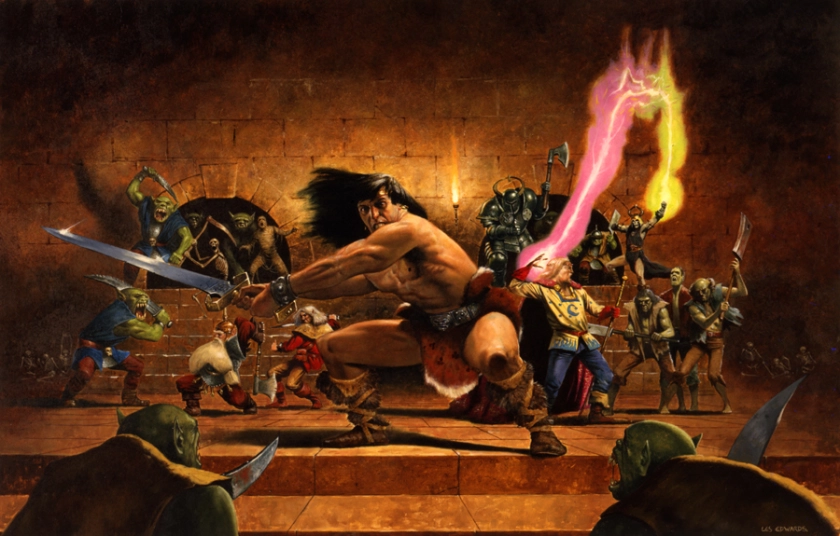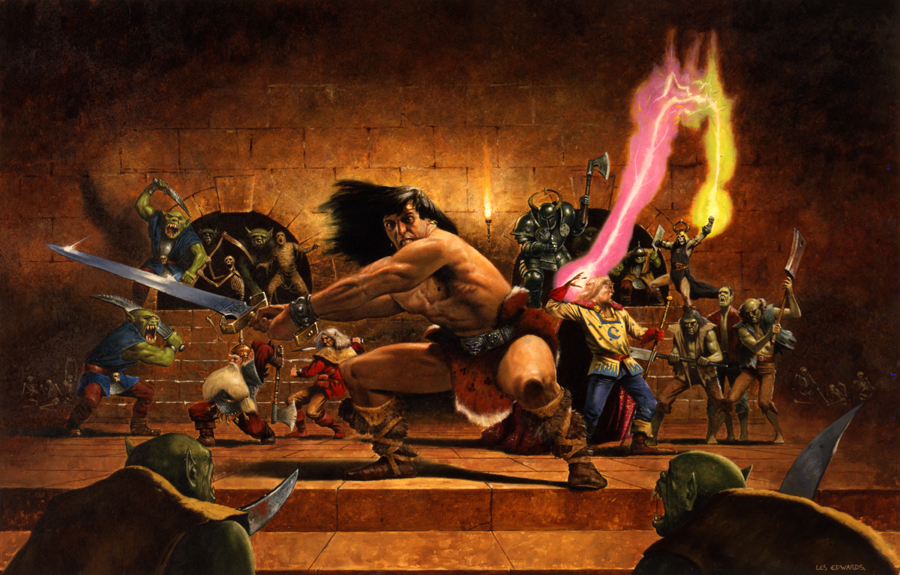HeroQuest is a wonderful game with very few flaws, the largest of which may be the gameboard itself. While charming in its simplicity, the preprinted arrangement of corridors and rooms greatly limits the amount of potential variability between one quest and the next. There can be no vast chamber that dominates half of the board, no truly labyrinthine network of passages, and trap placement is generally predictable or entirely unavoidable. Luckily, this lack of variety is saved in no small part by the brilliant inclusion of miniature furniture. Tables can be used to obstruct movement, the Weapon Rack can be used to make an empty room into an armory, and the Torture Rack lets you know the consequences of failure! By simply decorating the board a little bit, the environments instantly feel less uniform and more immersive. And yet, even the furniture can become a little repetitive and in need of some… differentiation.
It started with the Bookcases. In creating the plastic insert for the carcase, it became readily evident that the proportions of the case were terribly off. In relation to its height, the shelves were either far too short or far too shallow, a problem that was partially solved by creating false backs for each shelf to reduce their depth. This did not, however, solve the problem of filling those shelves with interesting items. The books on the original cardboard inserts were impossibly short and thin for the three dimensional proportions. The shelves were too short for me to fit a well detailed crystal ball, a monstrous skull, or even one of the plastic rats form the game itself. Furthermore, my favorite skull from the Citadel Skulls box (the contents of which had also been used on the Torture Rack, Cabinet, and Alchemist’s Bench) was a Tyranid Genestealer skull, which bore some resemblance to a certain skull seen in a certain trophy case… So it was decided. In order to make the construction of a second Bookcase more satisfying, it would be greatly modified into a dungeon-worthy Trophy Cabinet!


The first step was to create the carcase. One common fantasy trope is the inability of evil doers to create beautiful or intricate objects themselves, forcing them to “acquire” such objects from those they terrorize. Following this line of thought, it seemed reasonable that the servants of Zargon/Morcar would repurpose a hutch or similar item of furniture in order to display their ill-gotten treasures. Having grown thoroughly sick of painting wooden furniture, this concept also permitted me to stray from natural color schemes in favor of a blue, milk-paint finish fitting of whatever unfortunate farmhouse these fiends had plundered. Of course, they would not take much effort in the upkeep of such an item, leading to much wear and degradation being evident.








Once the cabinet was constructed and painted, all that remained was to assemble a suitably impressive assortment of magical relics and spoils of conquest to populate the display. Other than the aforementioned skull, I set about choosing items that were representative of the most iconic artifacts from works of fantasy. I constructed the Necronomicon from Army of Darkness from styrene, and modified a Warhammer gauntlet to produce the Infinity Gauntlet from the Marvel Cinematic Universe. Luckily, the timing of this project also coincided with the receipt of a resin 3D printer (an Anycubic Photon Mono), allowing me to print items far more complex than I could ever manually produce. Some of these items were conveniently available from online sources (such as the Chachapoyan Fertility Idol from Raiders of the Lost Ark and the Sorting Hat from Harry Potter). Others I managed to digitally sculpt myself, including the Genie’s Lamp from Aladdin, the Ocarina of Time from The Legend of Zelda, a banner of House Frey from A Song of Ice and Fire (my surname happens to be Frey), a Palantir from The Lord of the Rings, and the jade emblem of Thulsa Doom from Conan the Barbarian. The process of translating these mental constructs into physical models through technology was very rewarding, if somewhat bittersweet given how easily it replaced the artistic skill that would have been previously required to manually sculpt such objects.






Overall, I’m very happy with how this turned out. It was a pleasure to work on the collection of trinkets, not only due to the excitement of dabbling in a new hobby with digital sculpting. With most of my projects taking long hours of work, it was quite a welcome release to have a smattering of small individual items which could be finished relatively quickly. The fact that they were also recognizable props from some of my favorite franchises didn’t hurt either! And now, at last, I am finally done with all the furniture from HeroQuest. It was rewarding, but very tedious. It won’t be long until the entire core box and first two expansions (Kellar’s Keep and Return of the Witchlord) are complete.
Wood:
Base coated with Field Blue (70.964). Lined with Dark Sea Blue (70.898). Shade with mix of two for grain and edges. Highlight with Pale Grey Blue (70.907)/Field Blue mix. Wood showing through with German Camo Black Brown, Splinter Blotches II (70.347), Dark Mud (70.316), and Medium Grey (70.987).
Fertility Idol and Genie’s Lamp:
The gold was painted using a standard non-metallic metal technique using the following colors: VMC German Camo Black Brown (70.822), VGC Heavy Brown (72.153), VGC Heavy Goldbrown (72.151), VMC Ice Yellow (70.858), VMC Ivory (70.918), and VMA Armor Brown (71.041).
Palantir:
The entire piece was base coated with VMC Black (70.950). The area that would eventually become the pupil was selected, and a pattern of flame-like tendrils were painted as though they radiated from this central point. This design was initially blocked in with VGC Bloody Red (72.010), followed by VGC Orange Fire (72.008), VMC Flat Yellow (70.953), and Schmincke Titanium White with each layer covering less and less of the flames. The pupil was then redrawn with VGC German Camo Black Brown (70.822), which was also used to touch up areas where the flames created too much coverage. Finally, some specular highlights were added to create the appearance of glass with Titanium White blended into the surrounding area with the inclusion of some German Camo Black Brown.
Necronomicon:
The entire face of the book was base coated with VGC Tan (72.066). The eyes, nostrils, and mouth were base coated with VMC German Camo Black Brown (70.822). The wrinkles in the face were then painted in with various mixes of Tan, VGC Charred Brown (72.045), VMC Desert Yellow (70.977), and VMC Ivory (70.918). The pages were then base coated with VMC Medium grey (70.987). The pages were then shaded with a coat of VGC Sepia Ink (72.091), and the cover was shaded with several coats of thin Citadel Agrax Earthshade. This process was repeated several times, with reapplication of the various paint mixes followed by washes of the Agrax Earthshade until I was satisfied with the overall look.
Infinity Gauntlet:
The gauntlet was painted with a standard non-metallic metal approach using the following colors from the Scale Color NMM Gold and Bronze set: Gobi Brown (SC12), Sahara Yellow (SC11), Tenere Yellow (SC10), and White Sands (SC09). (I was excited to try some Scale Color paints, and they were… okay. Still prefer Vallejo).
Ocarina of Time:
The flute was base coated with a 1:1 mix of VGC Night Blue (72.019) and VMC Azure (70.902). This was then blended into a layer of pure Azure, followed by a 1:1 mix of Azure and VMC Pale Blue (70.906), and finally a point highlight of the last mix and a dash of Schmincke Titanium White.
Banner of House Frey:
The background of the banner was painted with mixes of VMC Black (70.950) and VMC Pale Blue (70.906) ranging from a 1:1 mix to pure Pale Blue. The sigil and border were painted with mixes of VGC Night Blue (72.019) and Schmincke Titanium White. The gold pole was painted with VGC Heavy Goldbrown (72.151), VMA Armor Brown (71.041), and VMC Ice Yellow (70.858).
Thulsa Doom’s Medallion:
The jade medallion was base coated with VMC Uniform Green (70.922). The major forms were then lightened with progressive mixes of Uniform Green and VMC Green Sky (70.974), mixes of Green Sky and VMC Green Grey (70.971). Color variation was achieved with some glazes of VMC Ice Yellow (70.858) to areas of highlight and VMA Armor Brown (71.041) to areas of shade.
Not-Xenomorph Skull:
The entire skull was base coated with VMC Khaki (70.988). The forms of the bones were lightened with progressive mixes of Khaki and VGC Bonewhite (72.034), followed by mixes of Bonewhite and VMC Ivory (70.918). Final highlights were applied with pure Ivory.
Sorting Hat:
The entire hat was base coated with VMC Chocolate Brown (70.872). Shade was applied in deep recesses with a 1:1 mix of Chocolate Brown and VMC Black (70.950). The forms of the hat were brightened with progressive mixes of Chocolate Brown and VMC Flat Earth (70.983), followed by mixes of Flat Earth and VMC Dark Sand (70.847). Scratches and texture were added with pure Dark Sand.


































































































